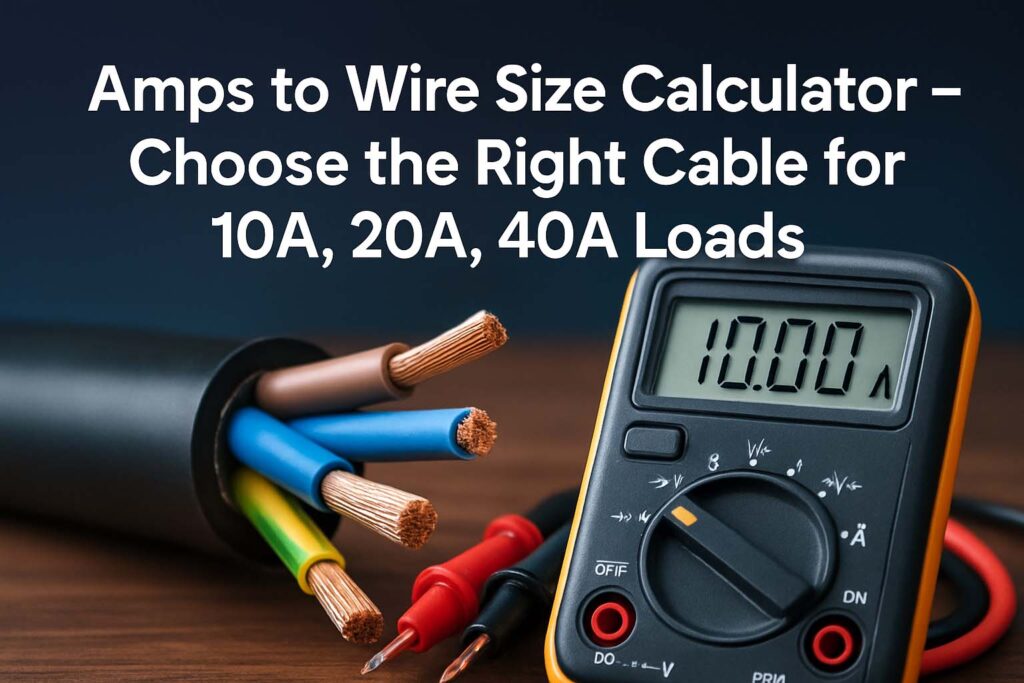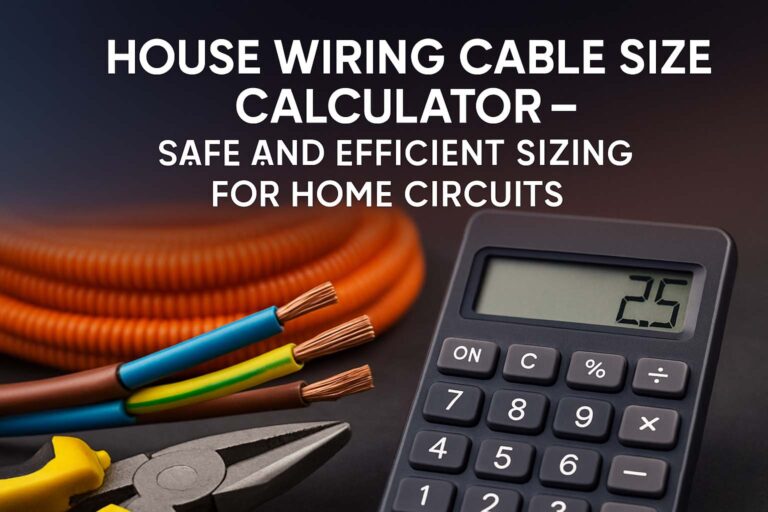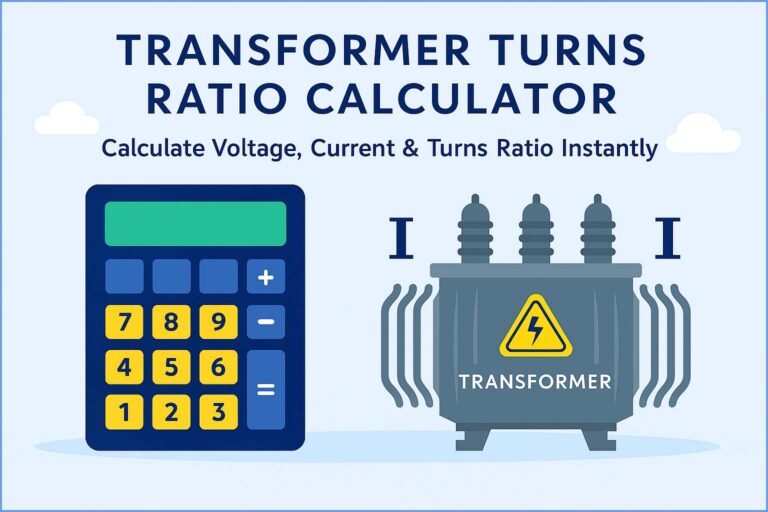Amps to Wire Size Calculator – Choose the Right Cable for 10A, 20A, 40A Loads
Choosing the right wire size for electrical loads is critical in any home, commercial, or solar installation. Whether you are wiring a simple outlet or running power to a subpanel, the wire gauge must be adequate for the current it will carry. That’s where an amps to wire size calculator becomes an essential tool.

Many users often ask, “What is the right 10 amp wire size?” or “Which 40 amp cable gauge should I use?” This article will walk you through how to determine the correct wire gauge using both rule-of-thumb standards and proper calculation methods.
Key Takeaways
- Using the wrong wire size can lead to overheating and safety hazards.
- A wire’s size must match the amperage it carries and the distance it runs.
- This guide helps you find the correct amps to wire size for 10A, 20A, and 40A loads.
- Learn how voltage drop, cable type, and insulation affect wire sizing.
- Includes a practical amps to wire size calculator explanation and tables.
Amps to Wire Size Calculator
Use our online free tool Wire Size Calculator for Solar Panels – Avoid Power Loss in Off-Grid and Hybrid Systems
Understanding Amps to Wire Size
Amperage (amps) measures the current flow through a conductor. Wire size or wire gauge, measured using the American Wire Gauge (AWG) system, indicates how thick a wire is.
The relationship is simple:
- More amps require a thicker wire.
- Longer distances also require a thicker wire to avoid voltage drop.
If the wire is too small for the current, it can overheat, melt insulation, and even cause electrical fires. Using an amps to wire size calculator or reference table ensures safety and compliance with electrical codes.
What Factors Affect Wire Size?
Choosing the right wire gauge isn’t just about amps. Consider these technical aspects:
- Voltage drop: Long cable runs cause voltage loss. To reduce this, you may need to upsize the wire.
- Cable insulation type: Different wire types (e.g., THHN, NM-B, or UF) have different temperature ratings.
- Installation conditions: Wires in conduit or underground need derating for heat and grouping.
- Material: Copper has better conductivity than aluminum, so wire sizes differ.
Let’s now break down wire sizes for 10A, 20A, and 40A loads, with clear technical reasoning.
Use our online free tool Free Electrical Wire Size Chart & Calculator – Find the Right Cable Every Time
10 Amp Wire Size – What Gauge Do You Need?
When carrying a 10 amp load over a standard distance (less than 50 feet), the most suitable wire size is 18 AWG or 16 AWG in some conditions. But for safety and voltage stability, 14 AWG copper wire is widely used.
Recommended 10A Wire Sizes
| Wire Gauge (AWG) | Material | Max Amps (Copper) | Max Distance (120V, 3% Drop) |
|---|---|---|---|
| 18 AWG | Copper | 10 Amps | 15 ft |
| 16 AWG | Copper | 13 Amps | 20 ft |
| 14 AWG | Copper | 15 Amps | 30 ft |
Why 14 AWG is preferred?
Though 18 AWG can handle 10A, the safety margin is tight. Using 14 AWG allows better heat dissipation and flexibility for future upgrades. For longer distances, 12 AWG is a safer bet.
Common Uses:
- LED lighting circuits
- Outdoor lights
- Small appliances
Always verify the insulation type and temperature rating before finalizing the 10 amp wire size.
20 Amp Load – Safe Wire Size Selection
For a 20 amp load, the NEC (National Electrical Code) recommends 12 AWG copper wire. However, this is true for short runs (up to 50 feet). For longer distances or aluminum conductors, wire size must be increased.
Use our online free tool Online Wire Gauge Calculator for 1 Phase and 3 Phase Load – Amp and Distance Based
Recommended Wire Sizes for 20 Amps
| Wire Gauge (AWG) | Material | Max Amps (Copper) | Max Distance (120V, 3% Drop) |
|---|---|---|---|
| 12 AWG | Copper | 20 Amps | 40 ft |
| 10 AWG | Copper | 30 Amps | 70 ft |
| 8 AWG | Aluminum | 40 Amps | 60 ft |
Why Upsize to 10 AWG for Distance?
At longer cable lengths, voltage drop increases. A 10 AWG copper wire reduces loss and improves efficiency. Especially for sensitive devices like motors or heaters, this matters.
Common Uses:
- Kitchen outlets
- Air conditioning units
- Power tools in workshops
Choosing the right wire gauge is about more than code compliance—it ensures performance.
40 Amp Cable Gauge – A High Current Case
When running a 40 amp load, the correct cable size becomes more critical due to the larger current.
The typical recommendation is 8 AWG copper or 6 AWG aluminum, but depending on length and application, 6 AWG copper is often the safest choice.
40 Amp Cable Gauge Chart
| Wire Gauge (AWG) | Material | Max Amps | Max Distance (240V, 3% Drop) |
|---|---|---|---|
| 8 AWG | Copper | 40 Amps | 50 ft |
| 6 AWG | Copper | 55 Amps | 75 ft |
| 4 AWG | Aluminum | 65 Amps | 80 ft |
Important Notes:
- For 40A continuous loads (like EV chargers or heavy HVAC units), NEC requires 125% rating, so 50A wire is recommended.
- 6 AWG copper offers both headroom and voltage drop protection.
Use our online free tool What Gauge Wire Do I Need? Free Online Calculator for Electricians & Homeowners
Common Applications:
- Electric vehicle charging stations
- Large water heaters
- Commercial HVAC systems
Never compromise on 40 amp cable gauge. Undersizing can cause dangerous heat buildup.
How to Use an Amps to Wire Size Calculator
Using an amps to wire size calculator is simple if you know the following:
- Amps of your load
- Voltage level (120V or 240V)
- Distance (one-way)
- Cable material (Copper or Aluminum)
- Installation type (in conduit, air, underground)
The calculator applies Ohm’s Law and voltage drop formulas like:
Voltage Drop (V) = (2 × K × I × D) / CM
Where:
- K = resistivity constant (Copper = 12.9, Aluminum = 21.2)
- I = current in amps
- D = distance in feet
- CM = circular mils of wire
Or you can use online tools where you plug in values and get the right AWG.
Always round up the result to the next thicker wire size for safety.
Use our online free tool NEC Wire Size Calculator – Voltage Drop Compliant Sizing for 120V & 240V Circuits
Choosing Between Copper and Aluminum
Both materials have their use cases, but here are the key differences:
- Copper wires are more conductive, need smaller sizes, and are more flexible.
- Aluminum wires are cheaper but require upsizing by about 2 wire gauges.
- Use antioxidant compound when terminating aluminum to prevent corrosion.
For residential loads like 10A or 20A, copper is generally preferred. For 40A or larger loads over long distances, aluminum can be economical.
Practical Tips for Selecting Wire Size
- Always follow local electrical codes – they may override standard recommendations.
- Leave room for future expansion – don’t size wire for today only.
- For underground runs, use direct burial-rated cable like UF or USE.
- Check the temperature rating of the breaker and conductor – 60°C, 75°C, or 90°C.
Use our online free tool Solar System Sizing Calculator for Agriculture & Tubewells
Conclusion
Selecting the correct wire size based on amperage is critical for safety, efficiency, and compliance. Whether you’re working with 10 amp, 20 amp, or 40 amp loads, using an amps to wire size calculator can take the guesswork out of electrical planning.
Here’s a quick recap:
- Use 14 AWG copper for 10A circuits with short runs
- Go with 12 AWG copper for 20A loads; upsize to 10 AWG if running long
- Choose 6 AWG copper or 4 AWG aluminum for 40A loads with confidence
Follow Us on Social:
Subscribe our Newsletter on Electrical Insights for latest updates from Electrical Engineering Hub
#WireSizeCalculator, #AmpsToWireSize, #ElectricalWiring, #CableSizing, #10AmpWireSize, #20AmpWireSize, #40AmpCable, #ElectricalSafety, #HomeWiring, #ElectricLoadCalculator, #WireGaugeChart, #WireSizeGuide, #VoltageDrop, #ElectricianTools, #DIYWiring
Amps to Wire Size Calculator – Choose the Right Cable for 10A, 20A, 40A Loads : Electrical Engineering Hub

Use our Amps to Wire Size Calculator to choose the correct cable for 10A, 20A, and 40A loads. Ensure safe wiring, prevent voltage drop, and follow electrical standards with this easy online tool
Price Currency: USD
Operating System: All
Application Category: UtilitiesApplication






